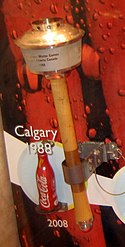User:Zanimum/1988 Winter Olympics torch relay

The 1988 Olympic torch relay began on November 15, 1987, when the torch was lit at Olympia and Greek runner Stellos Bisbas began what was called "the longest torch run in history".[1] The flame arrived in St. John's, Newfoundland on the Atlantic Ocean two days later and over 88 days traveled west across Canada. It passed through most major cities, north to the Arctic Ocean at Inuvik, Northwest Territories, then west to the Pacific Ocean at Victoria, British Columbia before returning east to Alberta, and finally Calgary.[2] The torch covered a distance of 18,000 kilometres (11,000 mi), the greatest distance for a torch relay in Olympic history until the 2000 Sydney Games, and a sharp contrast to the 1976 Montreal Games when the relay covered only 775 kilometres (482 mi).[3]
Relay sponsor Petro Canada issued entry forms allowing citizens the chance to become one of 6,214 people to carry the torch for 1 kilometre (0.62 mi). Organizers, who initially expected to receive 250,000 entries, were inundated with over 6.6 million forms and called the response a sign that the Olympics had "fired the imagination of Canada".[4] The relay, called "Share the Flame", also saw the torch travel by boat, snowmobile and dogsled.[5]

The relay was subject to peaceful protests by members and supporters of the Lubicon Cree First Nation at several stops in Ontario and Alberta in protest of ongoing land claim disputes between the band and the Crown, as well as discontent over an exhibit at Calgary's Glenbow Museum called "The Spirit Sings" that featured numerous artifacts stolen from native land.[5]
The identity of the final torchbearer who would light the Olympic cauldron was one of OCO'88's most closely guarded secrets.[6] The relay began at St. John's with Barbara Ann Scott and Fred Hayward representing Canada's past Olympians, and ended with Ken Read and Cathy Priestner carrying the torch into McMahon Stadium representing the nation's current Olympians. They then handed the torch to 12-year-old Robyn Perry, an aspiring figure skater who was selected to represent future Olympians, to light the cauldron.[6] The choice of Perry was an unusual departure from most Games as the torch has typically been lit by a famous individual or group from the host nation.[7]
Constructed of maple and aluminum, the torch was designed to remain lit despite the sometimes adverse conditions of Canadian winters.[8] It was modeled after the Calgary Tower, constructed entirely of Canadian materials and designed to be light enough for the relay runners to carry comfortably.[9] The peak of the Calgary Tower itself was retrofitted to install a cauldron at its peak and was lit for the duration of the Games, one of several "replica cauldrons" constructed at Olympic venues throughout Calgary and Canmore.[10]
Relay elements
[edit]Torch
[edit]Route
[edit]See also
[edit]References
[edit]External links
[edit]Category:1988 Winter Olympics Category:Olympic torch relays
- ^ "Olympic torch begins journey to 1988 Winter Games", The Item (Sumter, SC), p. 4B, 1987-11-16, retrieved 2013-03-10
- ^ Dunn 1987, p. 125
- ^ Factsheet: The Olympic torch relay (PDF), International Olympic Committee, 2012, pp. 4–7, retrieved 2013-03-10
- ^ Ferguson, Derek (1987-04-15), "6.6 million applications made to tote Calgary Olympic torch", Toronto Star, p. A1, retrieved 2013-03-10(subscription required)
- ^ a b Gerlach 2004, p. 121
- ^ a b Busby, Ian (2013-02-13), "Secret Service", Calgary Sun, p. S3
- ^ They lit the flame: torch carriers of the last 20 years, Associated Press, 2004-08-12, retrieved 2013-10-13 – via Highbeam (subscription required)
- ^ Bradley, Jeff (1987-11-18), "Torch run starts Calgary Olympics", Spokane Spokesman-Review, p. D1, retrieved 2013-03-26
- ^ Norris, Alexander (1986-11-29), "Ottawa research team basks in glow of Olympic torch", Ottawa Citizen, p. A10, retrieved 2013-03-26
- ^ Joynt, Jerry (2013-02-09), "Tower flame kept secret until end", Calgary Herald, p. A17


